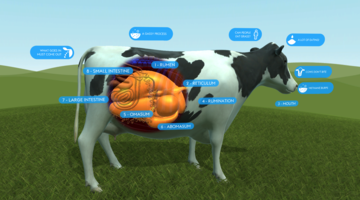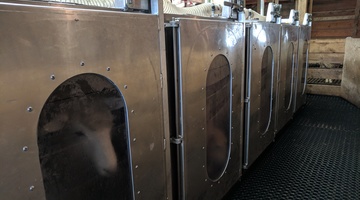Cows are ruminants. They have especially adapted digestive systems that allow them to only eat plants. Move your mouse or finger over any of the labelled boxes and click to obtain more information.
Go here to see the full transcript.

A cow’s digestive system contains a complex stomach with four chambers. The rumen is the largest of the four chambers and provides an environment where bacteria help ferment and digest plant material.
To use this interactive, move your mouse or finger over any of the labelled boxes and click to obtain more information.
Transcript
Burps
The rumen contains bacteria and protozoa that break down plant material using a process called fermentation. This process enables the cow to gain nutrition from a plant-based diet. A byproduct of fermentation is methane – a greenhouse gas. This gas is burped out by cows through their mouths. Cows produce 250–500 litres of methane a day, so research into reducing how much methane cows burp is important.
Image: Cows eating from a ‘green machine’ that measures methane output. © DairyNZ and The University of Waikato Te Whare Wānanga o Waikato.
Ruminant mouth
A grazing cow will use her tongue to wrap around grass and pull it into her mouth. Saliva helps lubricate the food and provides a medium for bacteria to attach to food particles.
Cows regularly regurgitate a food bolus for rechewing. This is called rumination. The chewing and rumination processes increase the surface area, making the feed particles more accessible to the microbes in the rumen for digestion.
Food particles are digested in the rumen by a process of fermentation. Methane gas is produced, which is released through burping/eructation by the cow. If the gas is not released, the cow will become bloated and potentially die.
Image: © Marga van Hulzen.
Rumen
The rumen is the fermentation vat. It is the largest part of the stomach. Its internal surface is covered with projections called papillae, which provide a greater surface area for absorption as well as supporting the mechanical movement of food around the rumen. It contains a large number of microbes – bacteria that digest the cellulose in the plant material. This releases the sugars and nutrients within the plant cells. The microbes that pass into the abomasum and small intestine are digested and provide a source of protein for the cows. The rumen and reticulum together can hold 50–120 litres of food and fluid.
Image: Dissection highlighting the rumen in a sheep, Dr Sarah Pain, Massey University.
Reticulum
The reticulum is not physically separated from the rumen. Its main role is to act as a filter, trapping larger feed particles that require further digestion. These larger food particles are regurgitated and rechewed – a process called rumination – with more saliva. They are then swallowed into the rumen again. Small food particles go straight into the omasum.
Image: The reticulum is highlighted in pink. The arrows show the direction of the bolus. © DairyNZ.
Omasum
The omasum is made up of lots of folds of tissue, almost like a leaf. This creates a large surface area to absorb water. It also acts as a filtration system and only allows fine particles and small amounts of fluid into the abomasum.
Image: Omasum with arrow showing the direction of food. © DairyNZ.
Abomasum
The abomasum is also referred to as the true stomach. It has a similar function to stomachs of other animals, like humans. It has a low pH – an acidic environment that kills the bacteria that pass from the rumen. The abomasum is where the digestion of microbial and dietary proteins begins.
Image: Abomasum with arrow showing the direction of food from the abomasum into the large intestine. © DairyNZ.
Small intestine
The small intestine is about 40 metres long. Its pH increases due to secretions from the pancreas, and there is a lot of enzymatic digestion of nutrients. The surface is covered with fine villi (finger-like projections). These increase surface area, allowing for maximum absorption of nutrients, proteins and fatty acids. The villi in the small intestine of a cow have a similar structure and function as those in other mammals, like humans.
Image: © The University of Waikato Te Whare Wānanga o Waikato.
Large intestine
The large intestine is the final part of the digestive tract. It is made up of the caecum and the colon. The main function of the large intestine is to absorb water and minerals. It also stores the waste product from the digestive system – faeces.
Image: The large intestine of a ruminant digestive tract, Dr Sarah Pain, Massey University.
Anus
The anus is a circular muscle located at the end of the digestive tract. The large intestine absorbs water and minerals and it also stores the undigested material from the digestive system – faeces. Faeces are expelled through the anus.
Video: © DairyNZ and The University of Waikato Te Whare Wānanga o Waikato.
Acknowledgement
This resource has been produced with the support of DairyNZ.




